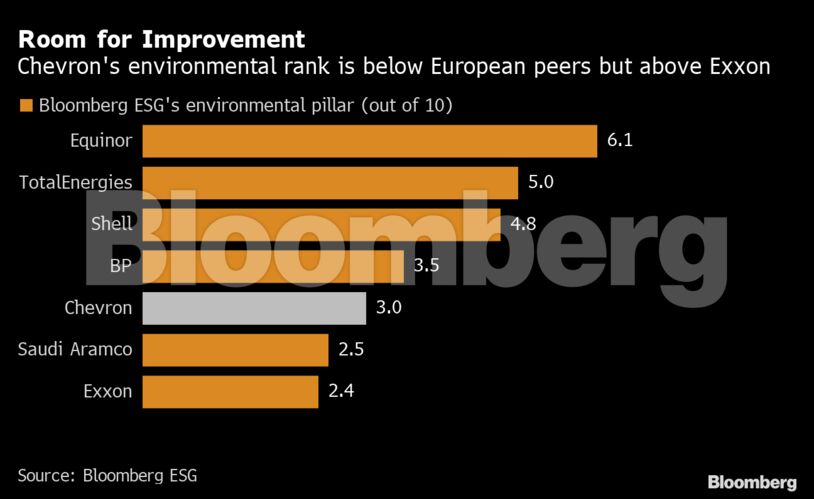Amid rising shareholder pressure on climate issues, Chevron is pro-actively forging climate-friendly joint ventures with an array of startups as well as corporate giants that include Caterpillar Inc., and Alphabet Inc.’s Google.
The moves come just months after tiny activist fund Engine No. 1 put the oil industry on notice that the days of ignoring appeals from climate-conscious investors are over. In a stunning reversal, Exxon Mobil Corp. was forced to surrender 25% of its board seats to outsiders after Engine No. 1 persuaded the oil titan’s largest shareholders to rebuff company leadership.
Chevron Chief Executive Officer Mike Wirth is expected to flesh out his “higher returns, lower carbon” strategy on Sept. 14 at the oil explorer’s first-ever ESG-focused investor day, titled “Energy Transition Spotlight.”
The event was arranged and announced a full two months before dissenting shareholders approved an emissions-reduction proposal opposed by the board of directors in late May.
“Investors aren’t yet buying what Chevron is selling on climate,” said Andrew Logan, director at Ceres, a coalition of environmentally active investors managing $37 trillion. “Investor patience has really run out with this sector and investors aren’t afraid to shake up boards if they don’t see a response to their concerns.”
CNG Stations
Chevron’s efforts at appeasement have included the creation of Chevron New Energies in July to invest in low-carbon technologies. The most recent was Thursday’s agreement with Mercuria Energy Trading to sell compressed natural gas as motor fuel.
Wirth has no easy task ahead. Unlike its biggest European rivals, Chevron hasn’t established any targets aimed at eliminating carbon emissions. The driller’s environmental pillar score of 3.01 out of 10 is below those of Equinor ASA and Royal Dutch Shell Plc, but surpasses Exxon, Saudi Aramco, and the state-backed oil majors in Russia and China, according to Bloomberg’s ESG ratings.
Chevron’s emissions-reduction efforts focus on carbon intensity, or the pollution released for every unit of energy produced. The company has been successful in reducing this measure significantly over the past few years, but the metric is controversial because it allows wiggle room to continue increasing overall fossil-fuel production.
“You should want the best producers to be meeting the most demand that they can, so it’s not the dirtiest producer,” Wirth told a Sanford C. Bernstein & Co. conference in June. If the most-responsible drillers abandon oil production, “you could see more emissions rather than less.”
Next Focus
“Intensity metrics were invented by the oil and gas industry to create an illusion of emission progress, while allowing for exponential growth,” said Josh Eisenfeld of Earthworks, a non-profit that filed a greenwashing complaint against Chevron with the Federal Trade Commission in March. “The climate responds to overall emissions reductions, nothing else matters.”
Chevron declined to comment for this story.
“It’s certainly in Chevron’s interests to do whatever it can to avoid making themselves into the next target” of activists, Ceres’s Logan said. “Next week will go a long way into determining whether Chevron becomes the next focus or not.”
Share This:




 CDN NEWS |
CDN NEWS |  US NEWS
US NEWS 




























